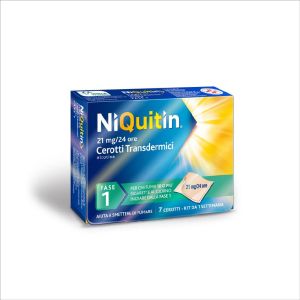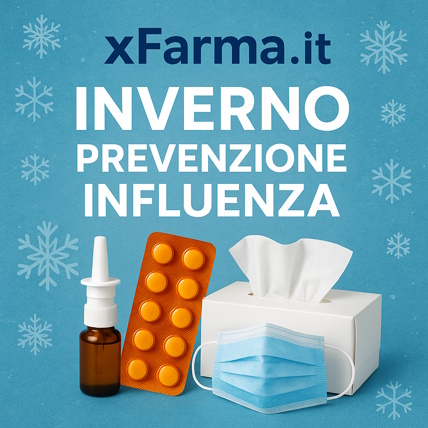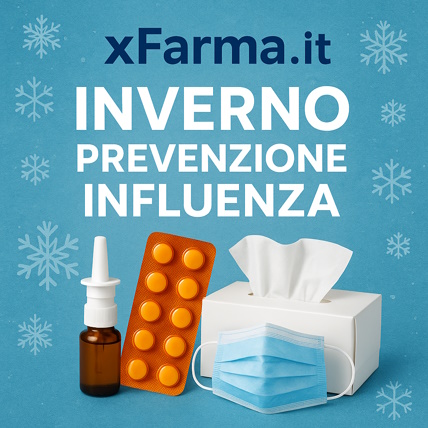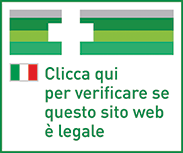Ship in Europe, Find out rates!
Niquitin 7 transd patches 21mg/24h

- box Delivery in Italy in 24/48 and free returns
- star3.000+ positive reviews
- dropboxOver 60,000 products in the catalog
Composition:
Each 22 cm² transdermal patch contains 114 mg of nicotine, equivalent to 5.1 mg / cm² of nicotine and releases 21 mg of nicotine in 24 hours. For the full list of excipients, see section 6.1.
Excipients
Active substance deposit: ethylene vinyl acetate copolymer. Back wall: polyethylene / aluminum / polyethylene terephthalate / ethylene vinyl acetate. Permeable membrane: polyethylene film. Adhesive Layer and Protective Foil: Polyisobutylene adhesive laminate. Printing ink: PMS 465 Brown ink.
Therapeutic indications
NiQuitin is indicated to relieve nicotine withdrawal symptoms including cravings by acting as a smoking cessation aid. If possible, when quitting smoking, NiQuitin should be used in conjunction with a behavioral support program. NiQuitin transdermal patches are indicated in adults and adolescents aged 12 years and over.
Contraindications
Hypersensitivity to the active substance or to any of the excipients listed in section 6.1. NiQuitin should not be used by: • children under 12 years of age; • occasional smokers; • Non-Smoking.
Dosage
Posology Adults (18 years and older) The patches should be used as indicated below. Before initiating therapy, candidates for transdermal nicotine use must wish to quit smoking. During a quit attempt, every effort should be made not to smoke while being treated with NiQuitin. The use of NiQuitin in conjunction with supportive behavioral therapy is recommended as this combination has been shown to be beneficial in smoking cessation therapy. NiQuitin should be applied once a day, at the same time and preferably as soon as you wake up and left at the application site for 24 continuous hours. NiQuitin therapy normally begins with the application of a 21 mg / 24 hour patch and is then tapered according to the following treatment schedule:
| dosage | duration | |
| first phase : | NiQuitin 21 mg / 24 hours | for the first 6 weeks |
| second phase : | NiQuitin 14 mg / 24 hours | for the next 2 weeks |
| third stage : | NiQuitin 7 mg / 24 hours | for the last 2 weeks |
Moderate smokers (who smoke less than 10 cigarettes per day) are recommended to start therapy from the second phase (14 mg) for 6 weeks and decrease the dose using the 7 mg / 24 hour patch for the final 2 weeks. Those who use NiQuitin 21 mg / 24 hours and suffer from excessive side effects, which do not resolve within a few days, should change the patch and use the 14 mg / 24 hour one. This dosage should be maintained for the remaining 6 weeks before switching to NiQuitin 7 mg / 24 hours for 2 weeks. If symptoms persist, seek advice from healthcare professionals. For best results, treatment should be completed in 10 weeks (8 weeks for moderate smokers or for those patients who have reduced their dosage as indicated above). NiQuitin treatment can be extended beyond 10 weeks if necessary to maintain smoking cessation, however those using patches beyond 9 months should consult with healthcare professionals. Individuals who continue or resume smoking may have additional courses of NiQuitin treatment. Pediatric population Adolescents (12 to 17 years of age) should follow the adult treatment schedule presented above for the first, second and third phases, but as the available data are limited, the duration of NST for this age group does not must exceed 12 weeks. If an extension is required, consult your healthcare professional. NiQuitin is contraindicated in children under 12 years of age. Method of administration NiQuitin transdermal patches should be applied to an area of hairless, clean and dry skin. The patch should be applied immediately after removing the protective pouch. Avoid application to wounded, inflamed or irritated skin. After 24 hours the used patch should be removed and a new patch applied to a different skin area from the previous one. The patch should not be left on for more than 24 hours. The same skin area can be reused after at least 7 days. Use only one patch at a time. The patches can be removed before bed if desired. However, it is recommended to use it for 24 hours continuously, to optimize the effect against the morning desire to smoke. Particular care should be used while using the patch to avoid contact with eyes or nose. Wash your hands after application with water only as soap can increase nicotine absorption.
Warnings and Precautions
The well-proven dangers of smoking are of considerably greater significance in virtually all circumstances than the risks associated with the use of NST. Patients admitted for myocardial infarction, severe arrhythmia, or cardiovascular disorders deemed hemodynamically unstable should be encouraged to quit smoking through non-pharmacological interventions. If unsuccessful, NiQuitin can be used, but as there are limited safety data available for this patient group, initiation of therapy should only take place under medical supervision. Once discharged from the hospital, patients can use NST normally. In the event of a clinically significant increase in cardiovascular or other effects attributable to nicotine, the dosage of the nicotine patches should be reduced or discontinued. Diabetes : Blood glucose levels may be more variable when you stop smoking, with or without NST as nicotine-induced catecholamine release can interfere with carbohydrate metabolism, so it is important for patients with diabetes to monitor their blood glucose levels more closely than usual when using such a drug. Allergic reactions : susceptibility to angioedema and urticaria. Atopic or eczematous dermatitis (due to local sensitization caused by the patch) : in the case of severe or persistent local reactions at the application site (for example severe erythema, itching or edema) or generalized skin reaction (for example hives or generalized skin rash) Patients should be advised to discontinue NiQuitin therapy and notify their physician. Contact sensitization : People with contact sensitization should be advised that severe reactions may occur following the use of other nicotine-containing products or smoking. The risk-benefit assessment should be made by a specialist for patients with the following conditions: • Renal and hepatic insufficiency : use with caution in patients with moderate to severe hepatic insufficiency and / or severe renal insufficiency since the clearance of the nicotine or its metabolites may be decreased with potential for increased side effects. • Pheochromocytoma and uncontrolled hyperthyroidism : Use with caution in patients with uncontrolled hyperthyroidism or pheochromocytoma as nicotine causes the release of catecholamines. Danger to Young Children : The amount of nicotine tolerated by adult smokers and adolescents can cause severe toxicity in young children with possible fatal outcome. Products containing nicotine must be kept out of the reach of children to prevent them from being misused or ingested. The patches should be folded double with the sticky side facing in and discarded carefully. Smoking cessation: The polycyclic aromatic hydrocarbons contained in tobacco smoke induce drug metabolism catalysed by CYP 1A2 (and possibly CYP 1A1). Stopping smoking can slow down the metabolism resulting in an increase in the plasma levels of these drugs. Addiction to NST : addiction to nicotine replacement therapy is rare and at the same time less harmful and easier to stop than that caused by smoking. Safe handling : NiQuitin is potentially a skin irritant and may cause contact sensitization.
Interactions
Clinically relevant interactions between nicotine replacement therapy and other drugs have not been demonstrated, however nicotine may enhance the haemodynamic effect of adenosine. Healthcare professionals are reminded that quitting smoking in itself may require adaptation of some drug therapies.
Side effects
Adverse reactions are listed below by system organ class and frequency. Frequencies are defined as: very common (≥1 / 10), common (≥1 / 100 to <1/10), uncommon (≥1 / 1000 to <1/100), rare (≥ 1 / 10,000 to <1/1000) and very rare (<1/10000), not known (cannot be estimated from the available data). The most frequent side effects associated with the use of NiQuitin are application site reactions. Other adverse events may occur and may be related to the pharmacological effects of nicotine or the effects of smoking withdrawal (see Pharmacodynamic properties). Some of the symptoms reported, such as depression, irritability, nervousness, agitation, mood swings, anxiety, drowsiness, difficulty concentrating, insomnia and sleep disturbances, may be related to withdrawal symptoms associated with smoking cessation. People who quit smoking by any method may develop asthenia, headache, dizziness, cough, or flu-like symptoms. The undesirable effects listed below have been reported in clinical studies and / or spontaneously in the marketing phase of the product.
| System Organ Classification and Frequency | Adverse Reaction / Event |
| Disorders of the immune system | |
| uncommon | hypersensitivity * |
| very rare | anaphylactic reactions |
| Psychiatric disorders | |
| very common | sleep disturbances, including abnormal dreams and insomnia |
| common | nervousness |
| Nervous system disorders | |
| very common | headache, dizziness |
| common | tremor |
| Cardiac pathologies | |
| common | palpitations |
| uncommon | tachycardia |
| Respiratory, thoracic and mediastinal disorders | |
| common | dyspnoea, pharyngitis, cough |
| Gastrointestinal disorders | |
| very common | nausea, vomiting |
| common | dyspepsia, upper abdominal pain, diarrhea, dry mouth, constipation |
| Skin and subcutaneous tissue disorders | |
| common | increased sweating |
| very rare | allergic dermatitis *, contact dermatitis *, photosensitivity |
| Musculoskeletal and connective tissue disorders | |
| common | arthralgia, myalgia |
| General Disorders and Administration Site Site Conditions | |
| very common | application site reactions * |
| common | chest pain *, limb pain *, pain, asthenia, fatigue / malaise |
| uncommon | flu-like syndrome |
* The majority of these local reactions are mild and resolve quickly upon removal of the patch. Pain or a feeling of heaviness may occur in the limb or patch application area (eg chest). In the event of a clinically significant increase in cardiovascular or other effects attributable to nicotine, the dosage of NiQuitin should be reduced or the application discontinued. Pediatric population (12 to 17 years of age) There are no specific adverse event data for this population. However, the frequency, type and severity of adverse reactions in adolescents are expected to be the same as in adults, based on a pharmacokinetic study which demonstrated a similar pharmacokinetic profile in the adolescent group compared to adults.
Pregnancy and breastfeeding
Pregnancy Smoking in pregnancy is associated with risks such as intrauterine growth retardation, premature birth or perinatal mortality. Quitting smoking is the only truly effective intervention to improve both the health of the smoking mother and her baby. The sooner abstinence is achieved the better. The ideal would be to be able to quit smoking during pregnancy without the help of NST. However, women who are unable to quit on their own may be recommended by healthcare professionals to use NST to help them in an attempt to quit. The risk associated with the use of NSN to the fetus is less than that associated with tobacco smoke, thanks to a lower maximum plasma nicotine concentration and the absence of exposure to polycyclic hydrocarbons and carbon monoxide. In any case, since nicotine passes to the fetus by altering respiratory movements and has a dose-dependent effect on the placenta / fetus circulation, the decision to use NST must be made as early as possible during pregnancy. The goal is to use NST for only 2–3 months. Products that supply nicotine intermittently are preferable as they generally provide a lower daily dose of nicotine than patches. However, the latter are recommended for women who experience nausea during pregnancy. If the patches are used they must be removed before going to bed. Breastfeeding The nicotine from smoking and NST is found in breast milk. However, the nicotine concentration in the child following exposure to NST is relatively low and less harmful than secondhand smoke to which the child would otherwise be exposed. The use of discontinuous dose NST preparations, compared to patches, may minimize the nicotine concentration in breast milk since the time between NST administration and breastfeeding can be more easily prolonged. Fertility There are no relevant data available. See paragraph 5.3
| Destination | Cost | Detail |
|---|---|---|
| Italy | €5,90* | 24/72H |
| Austria, France, Germany, Slovenia | € 13* | 3 days |
| Belgium, Luxembourg, Portugal, Netherlands, Spain | € 14* | 4 days |
| Bulgary, Cechia, Hungary, Poland, Romania, Slovakia | € 19* | 5 days |
| Denmark, Estonia, Finland, Ireland, Lithuania, Latvia ,Sweden | € 22* | 5 days |
| United Kingdom, Switzerland, Greece, Malta/td> | € 30* | 7 days |
| Canada | € 40 | 7 Days |
European shipments with express courier: FedEx, MBE, DHL
*For the shipment outside band B ther's an extra cost of 22€ *For the shipment outside band C ther's an extra cost of 30€ Delivery Times exclude Saturday and Holidays
For Islands and Areas of difficult Accessibility the shipments are made in 72 hours and the cost will be increased by 15€


